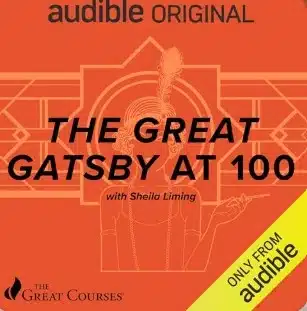Please scroll down for an English review.
במלאת מאה שנה לפרסום "גטסבי הגדול" של פ. סקוט פיצג'רלד, שילה לימינג מציעה סדרת הרצאות מעמיקה הבוחנת את הרומן הקלאסי ואת הרלוונטיות המתמשכת שלו. במהלך שש הרצאות, לימינג, פרופסורית בקולג' שמפליין, מובילה את המאזינים דרך ההקשרים ההיסטוריים והתרבותיים של שנות ה־20 הסוערות , התקופה שבה נכתב הרומן , ובוחנת כיצד כל אלו עיצבו את האשליות ואת המעמדות החברתיים שמוסתרים מאחורי המסיבות המפוארות.
לימינג מתעכבת על האופן שבו "גטסבי הגדול" חוקר נושאים כמו מעמד חברתי, מגדר, מיניות והחלום האמריקאי. היא מדגישה את הדרך שבה הרומן מציג את הכללים הבלתי מדוברים של עושר ומעמד, ואת ההבטחות השקריות של הצלחה עצמית בעולם הנשלט על ידי פריבילגיות של כסף ישן. בנוסף, היא מצביעה על השפעת התרבות הפופולרית של התקופה על הדמויות והעלילה, ומראה כיצד כל אלה עדיין רלוונטיים גם במאה ה־21.
ההרצאות שלה משייטות במי המעמדות החברתיים , מהעשירים שירשו את כספם בזיעת אפו של הסבא שלהם (תום ודייזי, מישהו?) ועד לנובורישים שמנסים לקנות לעצמם מושב בשולחן היוקרתי. חלק ניכר מהמתחים ברומן נובע מהעימות המתמיד בין מי שנולד עם כפית כסף בפה, לבין מי שרק חולם על זהב. במרכזו של כל זה עומד ג'יי גטסבי , דמות מסתורית שהרכילות סביבה לא יודעת גבולות, ושאלות על מקורות עושרו רק מעצימות את האווירה המהוססת שבין אהבה לאינטרס.
לימינג גם לא מפספסת את הממד המגדרי. היא מראה שטום מייצג אידיאל גברי שמבוסס על כוח, עושר ואלימות , שילוב מסוכן שהופך אותו למדד שבו נשפטות דמויות אחרות. גבריותו מוצגת כשלמה ובלתי ניתנת לערעור, אפילו כשהוא עוטה בגדי רכיבה צמודים – בעוד גטסבי, לעומתו, נידון להיכשל בניסיון לחקות את הכוח הזה. דייזי, מצד שני, נראית כמו פלאפר אופיינית: מתרועעת בחופשיות, שותה, מעשנת , אבל לימינג מראה כיצד החופש הזה רק מסתיר את הפאסיביות שלה, את הנכונות להימכר לשני הגברים שמחזיקים בה כתכשיט נוצץ. דמותה של דייזי חושפת את המלכודת של הנשים בעידן החדש , מצד אחד נהנות מחירויות שלא היו קיימות לפני כן, ומצד שני מחזקות את הסדר הפטריארכלי שהופך אותן לחפצים.
לימינג קושרת את זה לא רק לרומן עצמו, אלא גם להיסטוריה התרבותית והפוליטית של התקופה , מאמריקה שלאחר מלחמת העולם הראשונה ועד הפוליטיקה של זכות הבחירה לנשים. היא טוענת בעדינות אך בתקיפות: החלום האמריקאי אולי מבטיח שוויון, אבל המציאות של "גטסבי" מוכיחה שזה חלום עם סדקים עמוקים מאוד.
היא גם מזכירה את הרקע האישי של פיצג'רלד: באותה שנה בה כתב את "גטסבי הגדול", פרסם מאמר ב"סאטרדיי איבנינג פוסט" שבו חשף איך הוא וזלדה בזבזו את כל הכנסותיו כסופר , ונשארו עם הרבה פחות זוהר והרבה יותר חובות (הרחבתי על המאמר הזה כאן: איך לחיות כמעט בחינם).
בסוף, לימינג חושפת איך פיצג'רלד רומז בעדינות –, ואז בועט בעוצמה , על האשליות שמאחורי "החיים הטובים": הפערים הכלכליים שדופקים בשקט בדלתות האחוזות, והכללים הבלתי כתובים שמגדירים מי בפנים ומי נשאר בחוץ. היא מראה איך פיצג'רלד מפרק את רעיון "החלום האמריקאי", שבו כל אחד יכול להתעשר בעבודה קשה, ובמקום זאת מציג מציאות שבה עושר מגיע דרך מזל, הונאה וקשרים , לא בהכרח דרך יושר או חריצות.
ואם חיפשתם דרך לראות את "גטסבי" לא כאשליה מצועצעת אלא כמראה אפלה לחברה האמריקאית , תקשיבו ללימינג. היא מציעה מבט רענן שמגרד את הציפוי המוזהב עד שהוא חושף את השריטות שמבעדן מציץ כל הכאב. וכך, מאה שנה אחרי, גטסבי ממשיך להזכיר לנו שהחלום האמריקאי הוא לא תמיד נוצץ כמו שמוכרים לנו.
The Great Gatsby at 100/Sheila Liming
Audible Edition, 5H, 2025
דירוג SIVI –
איכות אודיו –

(Or: How a Century-Old Novel Still Resonates Like a Timeless Tune in Our Shiny Bubble Age)
Marking the centennial of F. Scott Fitzgerald’s "The Great Gatsby," Sheila Liming offers a deep dive lecture series examining the classic novel and its enduring relevance. Over six lectures, Liming, a professor at Champlain College, guides listeners through the historical and cultural contexts of the Roaring Twenties, the era in which the novel was written, uncovering how these shaped the illusions and the hidden social classes beneath the glamorous parties.
Liming focuses on how The Great Gatsby explores issues like social class, gender, sexuality, and the American Dream. She emphasizes how the novel exposes the unspoken rules of wealth and status and the false promises of self-made success in a world run by old-money privilege. She also shows how the period's popular culture influenced the characters and the story, and how these themes remain powerfully relevant in the 21st century.
Her lectures navigate the turbulent waters of social hierarchy: from the old-money elite whose inheritance came from grandfathers’ sweat (Tom and Daisy, anyone?) to the nouveau riche scrambling to buy a seat at the exclusive table. Much of the tension in the novel stems from the constant conflict between those born with a silver spoon and those merely dreaming of gold. At the heart of it all is Jay Gatsby, an enigmatic figure whose rumored fortune only deepens the air of suspicion swirling around him.
Liming doesn’t skip the gender dynamics, either. She reveals how Tom embodies an ideal of masculinity built on physical dominance, wealth, and an arrogance that lets him wear tight riding clothes without ever compromising his manly aura. Gatsby, by contrast, is doomed to fail in his attempt to mimic that force. Daisy, meanwhile, might seem like the perfect flapper: drinking, smoking, and flirting. But Liming shows how that freedom hides Daisy’s passivity and readiness to be possessed by the two men fighting over her. Daisy enjoys liberties her Victorian mother could never have dreamed of, yet in the end, she strengthens the system that keeps her an object.
Lining these insights to broader cultural and political currents, from postwar America to the rise of women’s suffrage. She suggests that while the American Dream promises equality, the world of Gatsby proves it’s a dream riddled with cracks.
She also reminds us of Fitzgerald’s messy relationship with wealth: in the same year he wrote Gatsby, he confessed in The Saturday Evening Post how he and Zelda burned through all his earnings, leaving him with far more debts than glitter (more about that here: How to Live Almost for Free).
Ultimately, Liming reveals how Fitzgerald gently hints, and then kicks down the door, on the illusions behind the “good life”: the quiet economic gaps in mansion doorways, and the unwritten rules dictating who’s in and out. She shows how Fitzgerald dismantles the “American Dream” myth: instead of honest work leading to success, it’s luck, scams, and connections that truly build fortunes.
So if you’re looking to see Gatsby not as a sweet illusion but as a dark mirror of American society, listen to Liming. She offers a fresh perspective that scrapes off the gold leaf to reveal the cracks beneath. And so, a hundred years later, Gatsby still reminds us that the American Dream doesn’t always shine as brightly as we’re sold.
לגלות עוד מהאתר Sivi's Books
Subscribe to get the latest posts sent to your email.

